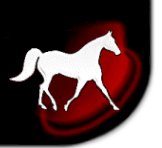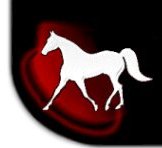|
Best times to
breed your mare.
The
mare's heat cycle is referred to as equine estrus, estrous or
oestrous cycle. It is the period of time which she will produce a
fertile egg (or ovulate) and will accept a stallion. A mares best times
for coming into heat are the warmer and longer days of the year, such
as mid to late spring and the summer
months.
Most mares will come into heat every 21 days. Usually 21 days after the
day the mare first comes into heat, she will start into heat again, but
some mares vary anywhere from 18 to 31 days in their heat cycles. Heat
periods are generally longer earlier in the breeding season and many
older mares have longer than average heat cycles.
Ovulation, or the period of time when the mare is fertile and can
conceive a foal generally only occurs 24
to 48 hours before the mare goes out of heat.
Thus no matter how long she is in heat, ovulation
will only occur shortly before the end of her heat cycle.
Sperm will only live in the mare's reproduction tract for about 24
hours, so it is absolutely
necessary to breed her shortly before she goes out of heat.
It is best to breed the mare on the second day of her heat cycle and
then breed her every other day until she goes
out of heat. That way she will
have live sperm in her genital tract when the egg is released from the
ovary.
Mare's that have just foaled will come into heat about 9 days after the
foal is born, but sometimes this varies from 4 to 18 days. This is
called the "foal heat". You can breed her at this time if she foaled
cleanly and without complications. If she had problems foaling, then
you should at least wait until her next heat period which will usually
occur 18 to 21 days after the foal heat. This will give her time to
heal and get ready to rebreed.
A mare is not too old to breed if she is in good health and if bred to
a stallion expected to produce a foal of normal size. Foaling or
birthing is easier on younger mares because their pelvis is held
together with more cartilage than bone. You should keep a closer eye on
an older bred mare.
Please note: All mares used for breeding should be examined and under a
veterinarians supervision. The above tips are not meant as a diagnosis,
treatment advise or replacement for the medical advisement of your
veterinarian. It is offered as a general informational resource based
on personal experience and study.
Horse
Health
| Foaling
Tips - Mares & Foals
Care
& Management of the Young Foal

|
Site Navigation
Home
Site
Search
Free Graphics
Animated
GIFS
Free
Clipart
Free
Ecards
FB
Timeline Covers
Large
File Clipart
Free
Backgrounds
Background
Sets
Matching
Sets
Buttons
MySpace
Graphics
Web
Fun & Help
Coloring
Pages
Flip
Text Tool
How
to Copy & Paste
Fun
& Games
Emotions/Emoticons
HTML
Tester
Jigsaw
Puzzle
Horse
Pages
Horse
Health
Breeding/Heat
Cycles
Foaling
Tips
Foal
Care
Foxtrotter
Training
Humor
Buying Guide
What
is Homozygous
Shopping
Pages
Gift
Shops
Horse
Posters
More
Pages
Missing
Children
Award
Winning Sites
Apply
Award
Links
Webrings
Site
Map |


